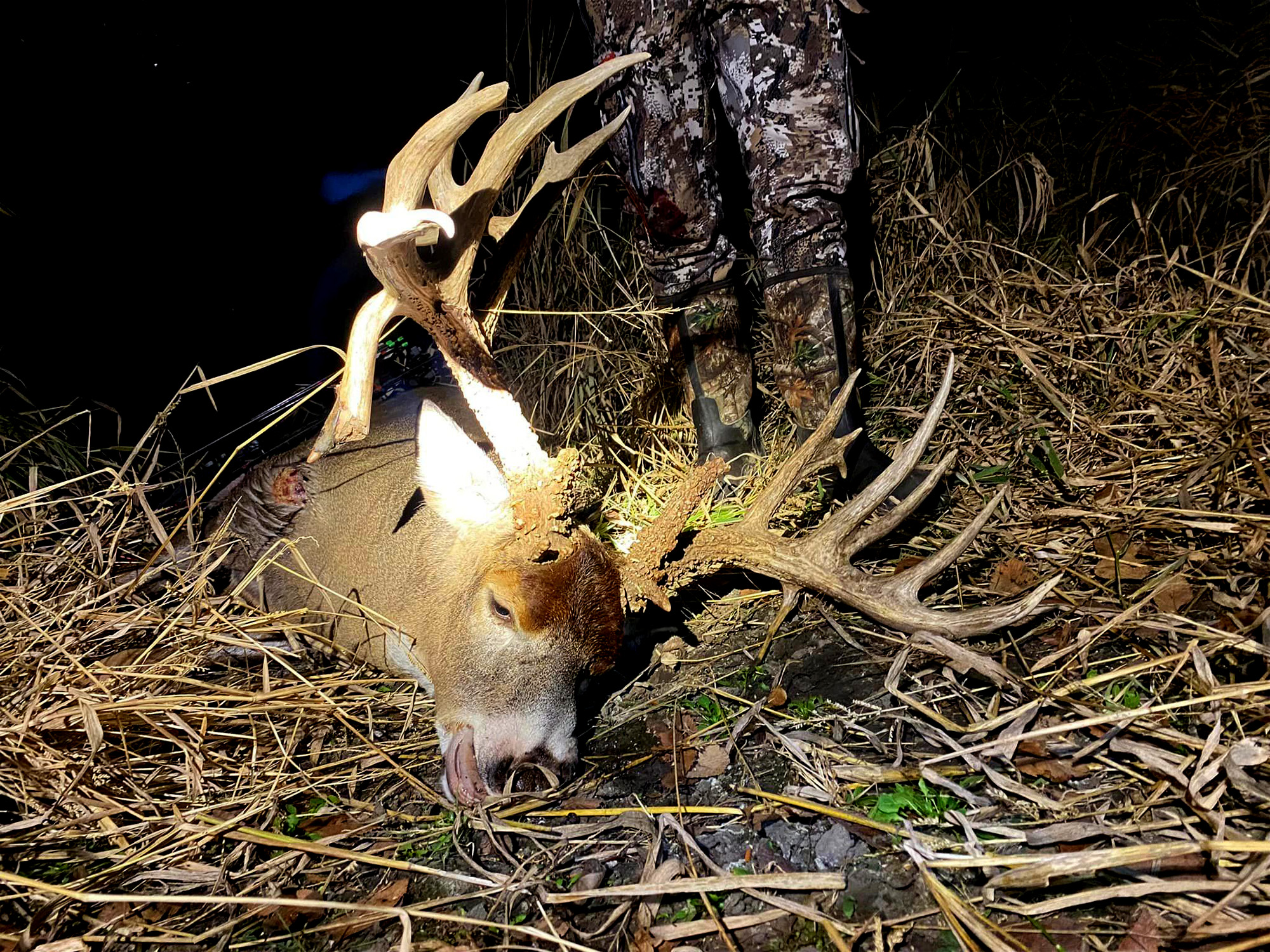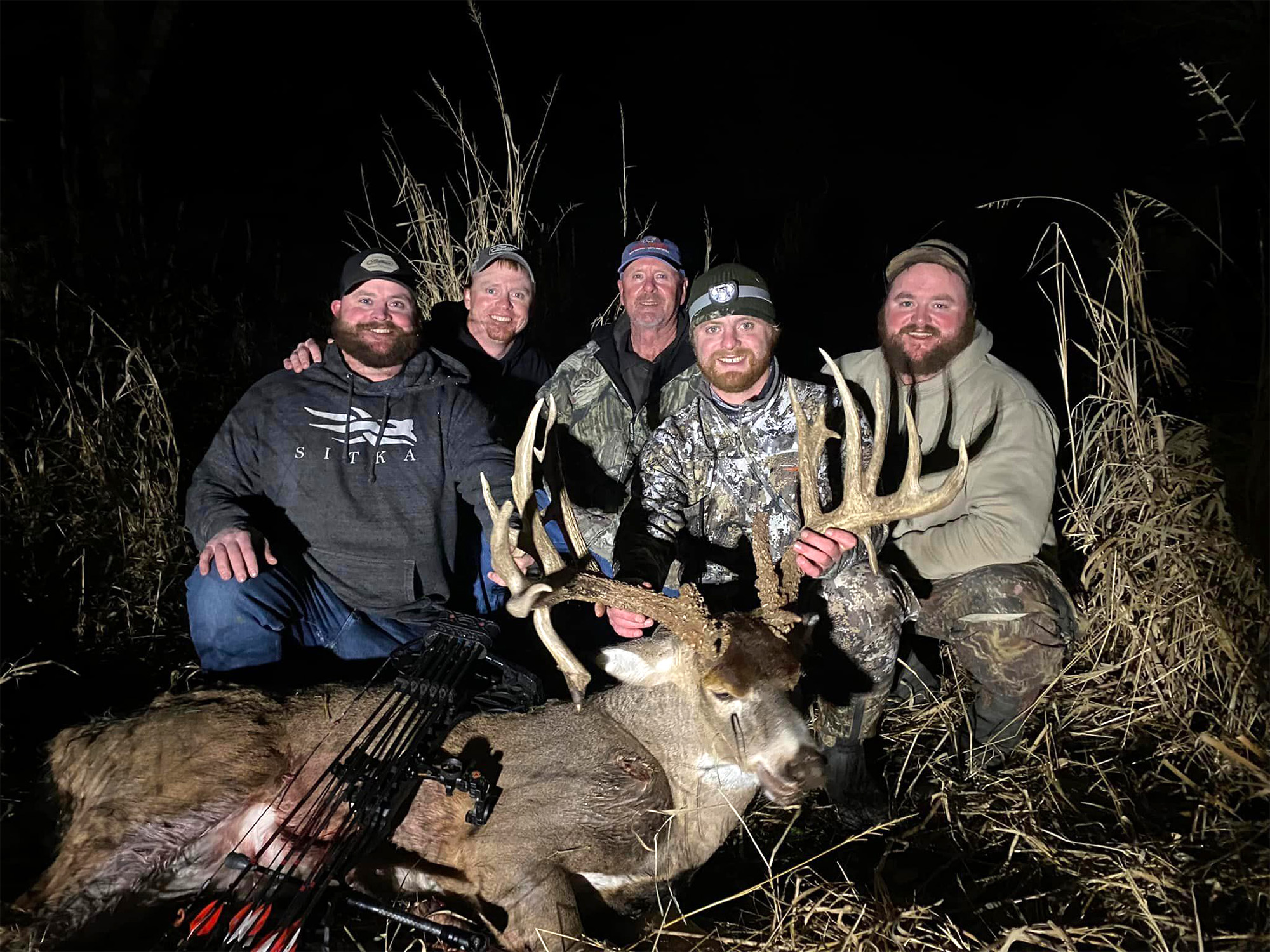For the last few years, Dalton Hiltibrand has been watching the same giant buck on an 80-acre parcel of private land in Nemaha County in northeast Kansas. Trail camera photos going back to 2020 showed that the huge, double drop-tine buck, nicknamed “Paraglider,” would regularly move off the property and onto other nearby farms.
“This year he showed up again in August,” Hilitibrand tells Outdoor Life. “But we only had a few photos of him during the day and night.”
On Nov. 15, Hiltibrand decided it was about time to make his move. With some help from his good friend Loren Henry and Henry’s two sons, they hung a lock-on stand in an evergreen tree near a spot where the buck had been photographed in previous years. The cellular cams captured photos of the giant buck over the next two days.
“I checked my phone the morning of Nov. 17, and there he was, and I knew I’d better try him at the stand that evening,” says the 25-year-old bowhunter from Seneca, Kansas. “A little cool front had come through, and it looked good for hunting, so I got up in the tree stand around 2 p.m.”
He’d only been up in the stand for about 20 minutes when he started seeing does. They were going back and forth between a rye field and a nearby bedding area with thick cover.
“A bit later I heard a deep growling kind of grunt,” Hiltibrand says. “It was coming from about 100 yards away in some thick evergreens. I thought it was from a mature buck, so I called softly with my grunt call, but nothing happened for about 20 minutes.”
Then, a 10-point buck appeared. It walked within 40 yards of Hiltibrand before it started chasing does. Around 4:15 p.m., he heard a buck grunting from a different direction, and then he spotted a doe walking toward the sound. Hiltibrand watched the doe closely as the giant, double drop-tine buck finally showed itself.
“That’s when the smaller 10-point buck spotted the doe in the ditch and he started chasing her,” Hiltibrand said. “The bigger buck bristled up, snort wheezed, and the big buck started after the doe, too.”
The bucks ran the doe about 300 yards away from Hiltibrand. The doe then circled back and came directly toward Hiltibrand with “Paraglider” right on her tail. The doe passed in front of him, and the buck stepped into his shooting lane from 23 yards away.
At 4:50 p.m., Hiltibrand drew his compound bow and released, sending a 100-grain expandable broadhead into the buck’s chest.

“I saw the arrow hit him, and knew it was a good shot, passing almost completely through the deer,” he says. “He ran to a grassy area and laid down. I tried looking for him through binoculars, but I was shaking too much to get a really good view.”
Hiltibrand quietly eased out of his tree stand and headed home. He called his friend Henry, then his father Mike and three brothers to let them know he’d made a good shot on the buck they all knew he was hunting.
They met at Hiltibrand’s house, where they watched some football while they waited for the buck to expire. Four hours later, they went back to the tree stand to track the buck. They found a blood trail right away.
“We followed the blood trail right to where I saw him in the grass, and he never moved, he was right there, dead,” Hiltibrand says.

The group loaded the massive buck into a truck and took it to Hiltibrand’s house. Once there, they compared its rack with some shed antlers they’d found last February and concluded they were from the same buck. They’d found the sheds roughly 70 yards away from where Hiltibrand shot the buck on Nov. 17.
Read Next: Teen Tags Monster Mule Deer, Finds Its Sheds 50 Yards from Where It Fell
Hiltibrand’s giant buck had an estimated live weight of 250 pounds. A local taxidermist gave it an unofficial green score of 235 inches.
“He’d broken off a couple of tines from fighting two weeks before I shot him, losing about 10 inches of antler mass,” says Hiltibrand, who noticed the broken tines when comparing the buck with past trail cam photos. “I’m still in awe about what happened. Patience, persistence, hard work, and sleepless nights paid off with lots of help from good friends like Loren Henry.”
Editor’s Note: This article was updated to clarify the location where the buck was killed. A previous version stated that Hiltibrand killed it in Nemaha County, Nebraska, when he actually killed the buck in Nemaha County, Kansas.
